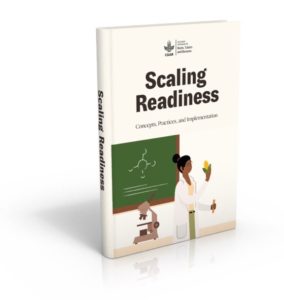 Sartas, M, Schut, M, van Schagen, B, Velasco, C, Thiele, G, Proietti, C and Leeuwis, C. 2020. Scaling Readiness: Concepts, Practices, and Implementation. CGIAR Research Program on Roots, Tubers and Bananas (RTB). January 2020.
Sartas, M, Schut, M, van Schagen, B, Velasco, C, Thiele, G, Proietti, C and Leeuwis, C. 2020. Scaling Readiness: Concepts, Practices, and Implementation. CGIAR Research Program on Roots, Tubers and Bananas (RTB). January 2020.Many of those innovations start as a bright idea that is then developed in a laboratory, to be tested subsequently with end-users. Although initial results and testing are often promising, few lead to real impact at scale.
Scaling Readiness aims to support organizations, projects, and programs in achieving their ambitions to scale innovations.
- It encourages critical reflection on how ‘ready’ innovations are for scaling and what appropriate actions could accelerate or enhance scaling.
- Scaling Readiness treats innovation as a flexible package of technological, organizational, and institutional components that may include crop varieties, machines or equipment, crop production practices, legislation, and marketing campaigns.
- It provides scientific tools to support decision making on what are the scaling bottlenecks to address what could be the most cost-effective scaling strategy and which partners to engage.
- Through its standardized data collection and analysis approach, Scaling Readiness can be used to monitor a portfolio of innovation and scaling investments.
- It also supports prioritization, and decisions on the advancement of those innovations that can achieve societal outcomes at scale in the most resource-efficient way.
Please visit the Scaling Readiness website or download directly the Scaling Readiness Guidelines for more information.
Background:
For the past three years, a group of dedicated scientists representing Wageningen University and the CGIAR have worked on the design and testing of Scaling Readiness. During this period, Scaling Readiness components contributed to scaling activities of more than 20 projects in 25 countries in Africa, Asia, and Latin America.
Some examples include high-quality cassava peels for animal feed in Nigeria, and sweetpotato puree for use in processed products in Uganda, Kenya, and Malawi. Although developed to support the scaling of agricultural innovations, Scaling Readiness principles can be applied to enhance the scaling of innovation in other sectors, including education, health, sanitation, and energy.

No comments:
Post a Comment